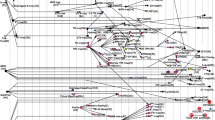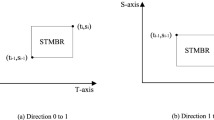Abstract
This paper presents a transportation spatio-temporal system that efficiently converts traffic video data into vehicular motion information in spatio-temporal databases for a variety of transportation applications. The proposed transportation spatio-temporal system interpolates the vehicle trajectory data (i.e., time, location, and speed), which are extracted from video, and integrates them with spatial road information for storage of dynamic transportation environments. The proposed transportation spatio-temporal system can mitigate data storage and retrieval issues related to storing large amounts of traffic video. Moreover, users can manage and operate multiform and multidimensional traffic data in a spatio-temporal transportation environment. The proposed approach is demonstrated for typical transportation applications. The experimental results show that the proposed transportation spatio-temporal system has excellent potential for addressing issues related to storage of large amounts of traffic video data.






















Similar content being viewed by others
References
Miller HJ (1999) Potential contributions of spatial analysis to geographic information systems for transportation. Geogr Anal 31:373–399
Butler AJ, Dueker KJ (2001) Implementing the enterprise GIS in transportation database design. URISA J 13(1)
Roess RP, Prassas ES, McShane WR (2011) Traffic Engineering, 4th edn. Pearson Prentice Hall, Upper Saddle River
Gong Y (2003) Audio and visual content summarization of a video program, chapter 10. In: Furht B, Marques O (eds) Handbook of video databases: design and applications
Wactlar HD, Christel MG, Gong Y, Hauptmann AG (1999) Lessons learned from building a terabyte digital video library. IEEE Comput 32:66–73
Aslandogan YA, Yu CT (1999) Techniques and systems for image and video retrieval. IEEE Trans Knowl Data Eng 11:56–63
Agma J, Traina M, Traina C Jr. (2003) Similarity search in multimedia databases, chapter 29. In: Furht B, Marques O (eds) Handbook of video databases: design and applications, pp. 712–245
Li L, Revesz PZ (2004) Interpolation methods for spatiotemporal geographic data. Comput Environ Urban Syst 28(3):201–227
Revesz PZ (2010) Introduction to database: from biological to spatio-temporal. Springer, New York
Chen CX (2001) Data models and query languages of spatio-temporal information. Ph.D. Dissertation, University of California, Los Angeles, CA
Yue H (2009) Advanced traveler information inquiry, archiving, and decision making system, the 4th Chinese Oversea Student “Chun Hui Cup” Entrepreneurship Competition, Project Presentation
Yin H, Wolfson O (2004) A weight-based map matching method in moving objects databases, the 16th International Conference on Scientific and Statistical Database Management
Liu J, Wolfson O, Yin H (2006) Extracting semantic location from outdoor positioning systems. International Workshop on Managing Context Information and Semantics in Mobile Environments
Cambridge Systematics, Inc. (2005) NGSIM U.S. 101 data analysis (7:50 a.m. to 8:05 a.m.), Prepared for Federal Highway Administration
Wei H, Feng C, Meyer E, Lee J (2005) Video-capture-based approach to extract multiple vehicular trajectory data for traffic modeling. J Transp Eng 131(7):496–505
Skabardonis A, Alexiadis V (2005) Traffic data through the Berkeley highway laboratory. Workshop on Traffic Modeling, Sedona, AZ
Kim Z, Gomes G, Hranac R, Skabardonis A (2005) A machine vision system for generating vehicle trajectories over extended freeway segments, the 12th World Congress on Intelligent Transportation Systems
Tao RH, Wei H, Wang YH, Sisiopiku VP (2004) Modeling speed disturbance absorption following state-control action-expected chains: integrated car-following and lane-changing scenarios, the 83rd Annual Meeting of Transportation Research, Washington, D.C
Wei H (1999) Observed lane-choice and lane-changing behaviors on an urban street network using video-capture-based approach and suggested structures of their models. Ph.D. dissertation, Univ. of Kansas, KS
U.S. Department of Transportation, Federal Highway Administration (2007) NGSIM-VIDEO user’s manual, Publication No. #FHWA-HOP-07-009
Patamanska G, Slavov N (2007) Using cubic spline interpolation to estimate vertical soil water profile. Bulg J Agric Sci 13:317–323
Boyko A, Pavlova V (1986) Restoration of soil moisture reserve profile using spline interpolation instrument. Tr VNISKHM 21:102–111
Thant A, Khaing A (2009) Application of cubic spline interpolation to walking patterns of biped robot. World Acad Sci Eng Technol 50:27–34
Su B, Tan J (2007) Sweeping surface generated by a class of generalized quasi-cubic interpolation spline. Int Conf Comput Sci (2):41–48
Dubau C (2011) Optimal property of the shape of aeolian blade profile using cubic splines. J Comput Anal Appl 13(1):254
Recktenwald G (2000) Numerical methods with MATLAB: implementation and application. Prentice Hall, Upper Saddle River
Guo D, Liu S, Jin H (2010) A graph-based approach to vehicle trajectory analysis. J Locat Based Serv 4:183–199. doi:10.1080/17489725.2010.537449
Liu S, Liu C, Luo Q, Ni L, Krishnan R (2012) Calibrating large scale vehicle trajectory data. Living Analytics Research Center (LARC), Technical Report Series: LARC-TR-01-12
Douglas D, Peucker T (1973) Algorithms for the reduction of the number of points required to represent a digitized line or its caricature. Can Cartographer 10:112–122
Jeung H, Yiu ML, Zhou X, Jensen CS, Taoshen H (2008) Discovery of convoys in trajectory databases. VLDB Endowment 1:1068–1080
Lee JG, Han J, Whang KY (2007) Trajectory clustering: a partition-and-group framework. In: Proceedings of the 2007 ACM SIGMOD International Conference on Management of Data, ACM Press, pp 593–604
Rinzivillo S, Pedreschi D, Nanni M, Giannotti F, Andrienko N, Andrienko G (2008) Visually driven analysis of movement data by progressive clustering. Inf Vis 7:225–239
Gindele T, Brechtel S, Dillmann R (2010) A probabilistic model for estimating driver behaviors and vehicle trajectories in traffic environments, the 13th International IEEE Annual Conference on Intelligent Transportation Systems, Madeira Island, Portugal
Egerstedt M, Martin CF (2001) Optimal trajectory planning and smoothing splines. Automatica 37:1057–1064
Shcherbakov MV, Brebels A (2011) Outliers and anomalies detection based on neural networks forecast procedure. In: Proceedings of the 31st Annual International Symposium on Forecasting, ISF-2011, pp 21–22
Pham-GIA T, Hung TL (2001) The mean and median absolute deviation. Math Comput Model 34:921–936
Shcherbakov MV, Brebels A, Shcherbakova NL, Tyukov AP, Janovsky TA, Kamaev VA (2013) A survey of forecast error measures. World Appl Sci J 24 (Information Technologies in Modern Industry, Education & Society):171–176, ISSN 1818–4952
Rousseeuwa PJ, Crouxa C (1993) Alternatives to the median absolute deviation. J Am Stat Assoc 88(424):1273–1283
Highway Capacity Manual (2000) Transportation Research Board; Bk&CD-Rom edition, ISBN-10: 9991332944, Chapter 7–3
Hastie T, Loader C (1993) Local regression: automatic kernel carpentry. Stat Sci 8(2):120–129
Nadaraya EA (1964) On estimating regression. Theory Probab Appl 10:186–190
Wathson GW, Leadbetter MR (1964) Hazard analysis I. Biometrika 51:175–184
Gasser T, Müller HG (1979) Kernel estimation of regression functions. In: Gasser T, Rosenblatt M (eds) Smoothing techniques for curve estimation. Springer, Heidelberg, pp 23–68
Silverman BW (1986) Density estimation for statistics and data analysis. Chapman and Hall, London
Fan J, Marron JS (1994) Fast implementations of nonparametric curve estimators. J Comput Graph Stat 3:35–56
Fan J, Gijbels I (1992) Variable bandwidth and local linear regression smoothers. Ann Stat 20(4):2008–2036
Ruppert D, Wand M (1994) Multivariate locally weighted least-squares regression. Ann Stat 22(3):1346–1370
Cheng MY, Fan J, Marron J (1997) On automatic boundary corrections. Ann Stat 25(4):1691–1708
Sun H, Liu HX, Xiao H, He RR, Ran B (2003) Use of local linear regression model for short-term traffic forecasting. Transp Res Board 18(1836):59–71
Fan J, Gijbels I (1996) Local polynomial modeling and its applications. Chapman & Hall, London
Smith B, Williams B, Oswald K (1999) Parametric and nonparametric traffic volume forecasting. Transportation Research Record. CDROM
Faouzi E (1996) Nonparametric traffic flow prediction using kernel estimator. Proceedings of the 13th International Symposium on Transportation and Traffic Theory, Lyon, France, July 19, pp 24–26
Rasmussen C, Williams C (2006) Gaussian processes for machine learning. MIT Press, Cambridge, Massachusetts
Anjyo K, Lewis JP. RBF interpolation and Gaussian process regression through an RKHS formulation. J Math Ind 3 (2011A-6):63–71
Williams CKI, Rasmussen CE (1996) Gaussian processes for regression. In: Proceeding of the Neural Information Processing Systems, vol 8. MIT Press
Stein ML (1999) Interpolation of spatial data: some theory for Kriging. Springer, New York
Ranjan P, Haynes R, Karsten R (2011) A computationally stable approach to gaussian process interpolation of deterministic computer simulation data. Technometrics 53(4):366–378
Yakowitz SJ, Szidarovszky F (1985) A comparison of Kriging with nonparametric regression methods. J Multivar Anal 16:21–53
Scott DW, Tapia RA, Thompson JR (1977) Kernel density estimation revisited. Nonlinear Anal Theory Methods Appl 1:339–372
Cleveland W (1979) Robust locally weighted regression and smoothing scatter plots. J Am Stat Assoc 74:829–836
Fan J (1992) Design-adaptive nonparametric regression. J Am Stat Assoc 87:998–1004
Wand MP, Jones MC (1995) Kernel smoothing. Chapman and Hall, London
Jones MC, Marron JS, Sheather SJ (1996) A brief survey of bandwidth selection for density estimation. J Am Stat Assoc 91(433):401–407
Scott DW, Terrell GR (1987) Biased and unbiased cross-validation in density estimation. J Am Stat Assoc 82:1131–1146
Bowman AW (1984) An alternative method of cross-validation for the smoothing of density estimates. Biometrika 71:353–360
Sheather SJ (1986) An improved data-based algorithm for choosing the window width when estimating the density at a point. Comput Stat Data Anal 4:61–65
Park BU, Marron JS (1990) Comparison of data-driven bandwidth selectors. J Am Stat Assoc 85:66–72
Sheather SJ, Jones MC (1991) A reliable data-based bandwidth selection method for kernel density estimation. J R Stat Soc Ser B 53:683–690
Engel J, Herrmann E, Gasser T (1995) An iterative bandwidth selector for kernel estimation of densities and their derivative. J Nonparametric Statist 4:21–34
Faraway JJ, Jhun M (1990) Bootstrap choice of bandwidth for density estimation. J Am Stat Assoc 85:1119–1122
Ruppert D, Sheather SJ, Wand MP (1995) An effective bandwidth selector for local least squares regression. J Am Stat Assoc 90:1257–1270
Yue H, Jones E, Revesz PZ (2010) Local polynomial regression models for average traffic speed estimation and forecasting in linear constraint databases, 17th IEEE International Symposium on Temporal Representation and Reasoning, Paris, France, pp 154–161
Yue H, Jones E (2010) Archiving capability of spatio-temporal data in different Highway Railroad Grade Crossing (HRGC) databases, Annual Intelligent Transportation System Conference, Houston, USA
Kanellakis P, Kuper G, Revesz PZ (1995) Constraint query languages. J Comput Syst Sci 51(1):26–52
Kerner BS (2009) Introduction to modern traffic flow theory and control: the long road to three-phase traffic theory. Springer, Berlin
Leutzbach W (1988) Introduction to the theory of traffic flow. Springer, Berlin
Al-Deek H, Abd-Elrahman A (2002) An evaluation plan for the conceptual design of the Florida transportation data warehouse, University of Central Florida, Technical Report No. 16-50-706
Dahlgren J, Garcia RC, Turner S (2001) Completing the circle: using archived operation data to better link decision to performance, California Path Research Report No. UCB-ITS-PRR-2001-23
Liu HX, He R, Tao Y, Ran B (2002) A literature and best practices scan: its data management and archiving, University of Wisconsin at Madison Technical Project No. 0092-02-11
Yue H, Yang R (2005) Development of Intelligent Transportation Systems (ITS) and plan of integrated information system. Journal of Wuhan University of Technology 29(4):560–563
Yue H, Revesz PZ (2012) TVICS: an efficient traffic video information converting system, 19th IEEE International Symposium on Temporal Representation and Reasoning, Leicester, UK, pp 141–148
Schwinn A, Schelp J (2003) Data integration patterns. Business Information Systems Conference, Colorado Springs, USA
Anderson S, Revesz PZ (2009) Efficient max count and threshold operators of moving objects. Geoinformatica 13(4):355–396
Acknowledgments
The authors gratefully acknowledge Elizabeth G. Jones for her comments about Fig. 7 and pointing out some related references.
Author information
Authors and Affiliations
Corresponding author
Rights and permissions
About this article
Cite this article
Yue, H., Rilett, L.R. & Revesz, P.Z. Spatio-temporal traffic video data archiving and retrieval system. Geoinformatica 20, 59–94 (2016). https://doi.org/10.1007/s10707-015-0231-0
Received:
Revised:
Accepted:
Published:
Issue Date:
DOI: https://doi.org/10.1007/s10707-015-0231-0




